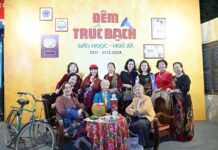As it is the most beautiful and prosperous village in the Central Highlands, Ako Dhong is also the only one which still maintains the unique features of an Ede traditional village.
|
|
Before 1975, Co Thon village had 10 families living in three Ede traditional long houses-on-stilts. There was a large well which provided water for the villagers’ daily use and 10ha of coffee.
After 1975, the village received state investment in constructing an infrastructure system. With their unity and mutual assistance, the villagers have stabilized economic development and improved their spiritual life.
In modern life, the villagers have preserved and developed the Ede cultural traditions. The village now has 40 traditional long houses-on-stilts with typical architecture of the Ede. The long houses are made from natural materials such as bamboo and wood. Many generations of a family live together in a long house and it is a typical feature in the matriarchal society of the Ede people. Once a girl living in the house gets married, the house is lengthened with a compartment because in Ede matriarchal society, men live in their wives’ houses.
Inside a house, the staircase is a cultural feature of the Ede people. It is made by hand and decorated with two breast-shaped designs at the top, the symbol of matriarchal vitality and power. They always keep several gongs in their houses because gongs are considered sacred items in the festive events of locals.
Besides engaging in agriculture, locals are also developing eco-tourism, showing off the values of the scenery and culture of the village that helps them improve their living conditions and preserve the traditional values of the village in the modern city.
|
Unique feature of the traditional long house-on-stilts of the Ede. |
Besides engaging in agriculture, locals are also developing eco-tourism, showing off the values of the scenery and culture of the village that helps them improve their living conditions and preserve the traditional values of the village in the modern city.



